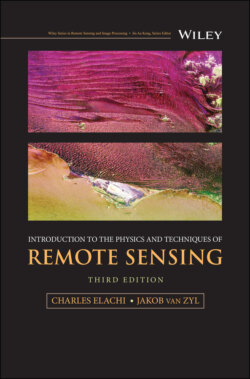Читать книгу Introduction to the Physics and Techniques of Remote Sensing - Jakob J. van Zyl - Страница 28
2.2.1 Radiation Quantities
ОглавлениеRadiant energy: The energy carried by an electromagnetic wave. It is a measure of the capacity of the wave to do work by moving an object by force, heating it, or changing its state. The amount of energy per unit volume is called radiant energy density.
Radiant flux: The time rate at which radiant energy passes a certain location. It is closely related to the wave power, which refers to the time rate of doing work. The term flux is also used to describe the time rate of flow of quantized energy elements such as photons. Then the term photon flux is used.
Radiant flux density: Corresponds to the radiant flux intercepted by a unit area of a plane surface. The density for flux incident upon a surface is called irradiance. The density for flux leaving a surface is called exitance or emittance.
Solid angle: The solid angle Ω subtended by area A on a spherical surface is equal to the area A divided by the square of the radius of the sphere.
Radiant intensity: The radiant intensity of a point source in a given direction is the radiant flux per unit solid angle leaving the source in that direction.
Table 2.1 Radiation quantities.
| Quantity | Usual symbol | Defining equation | Units |
|---|---|---|---|
| Radiant energy | Q | joule | |
| Radiant energy density | W | joule/m3 | |
| Radiant flux | Φ | watt | |
| Radiant flux density | E (irradiance) M (emittance) | watt/m2 | |
| Radiant intensity | I | watt/steradian | |
| Radiance | L | watt/steradian m2 | |
| Hemispherical reflectance | ρ | ||
| Hemispherical absorptance | α | ||
| Hemispherical transmittance | τ |
Figure 2.10 Concept of radiance.
Radiance: The radiant flux per unit solid angle leaving an extended source in a given direction per unit projected area in that direction (see Fig. 2.10). If the radiance does not change as a function of the direction of emission, the source is called Lambertian.
A piece of white matte paper, illuminated by diffuse skylight, is a good example of a Lambertian source.
Hemispherical reflectance: The ratio of the reflected exitance (or emittance) from a plane of material to the irradiance on that plane.
Hemispherical transmittance: The ratio of the transmitted exitance, leaving the opposite side of the plane, to the irradiance.
Hemispherical absorptance: The flux density that is absorbed over the irradiance. The sum of the reflectance, transmittance, and absorptance is equal to one.
